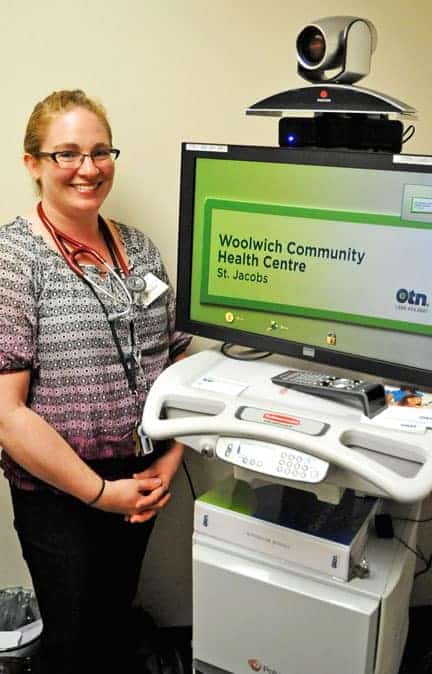The Woolwich Community Health Centre is bridging the gap between healthcare specialists – often located far outside of the Waterloo Region – and township residents via its telemedicine program.
Launched in 2012, the program allows patients to interact with doctors across the province through videoconferencing from the WCHC location at 10 Parkside Dr. in St. Jacobs.
![Woolwich Community Health Centre telemedicine nurse Jenn DeCosta uses a video conferencing unit to connect patients with health care professionals from around the province. [Scott Barber / The Observer]](https://www.observerxtra.com/content/images/wp-content/uploads/2014/10/post_telemedicine.jpg)
It’s a relatively simply application of the commonly used “Skype” or “Facetime” technologies popularized by Apple, that makes a real difference in people’s lives, WCHC telemedicine coordinator Jenn DeCosta said.
“LHIN 3 (Waterloo-Wellington Local Health Integration Network) is such a big territory. To drive from Harriston to Ayr would probably take an hour and a half, but population-wise, we are probably only a third of the population of Toronto. Depending on what your medical needs are, you might have to travel extreme distances to get the care you need. This program looks to cut down on that travel time and costs while helping to alleviate wait times.”
Anyone in Wellesley or Woolwich Townships can set up telemedicine appointments through their family doctor; you don’t need to be a WCHC client.
And there are a variety of ways the program serves patients, and is often used for psychiatry assessments, internal medical consults pre-op appointments and dermatology diagnosis.
“I do a lot of dermatology appointments,” DeCosta explained. “So we actually take pictures with a camera, upload them to a secure website and we usually receive results within the hour. The doctor gets a ding on their Blackberry, send the information back and away we go.”
If the patient needs something removed, DeCosta can send the referral to the plastic surgeon the same day. A big difference from the “six weeks to six-month wait” typical for most specialist appointments.
Earlier this year, the WCHC received a state-of-the-art teleconferencing unit nicknames “Robot,” which provides a zoom camera, handy for helping doctors asses skin wounds or surgical incision. DeCosta, a registered nurse practitioner, is also equipped with a digital stethoscope “with special software that enables the doctor at the other end to hear what she can hear in real time.”
The program is particularly useful for patients who either can’t drive or don’t have access to a vehicle, as well as those in the Mennonite community who might otherwise have a very difficult time accessing care from specialists in, say, downtown Toronto.
It’s certainly a unique way to experience the health care system, but one that DeCosta believes will become increasingly common.
“It’s a big part of medical school now,” she said. “It’s just one small way technology is able to make a huge impact on our healthcare system.
Currently, DeCosta typically assists patients at the WCHC, though the equipment is portable. In the future, she hopes to see the program expand to include regular house calls.








